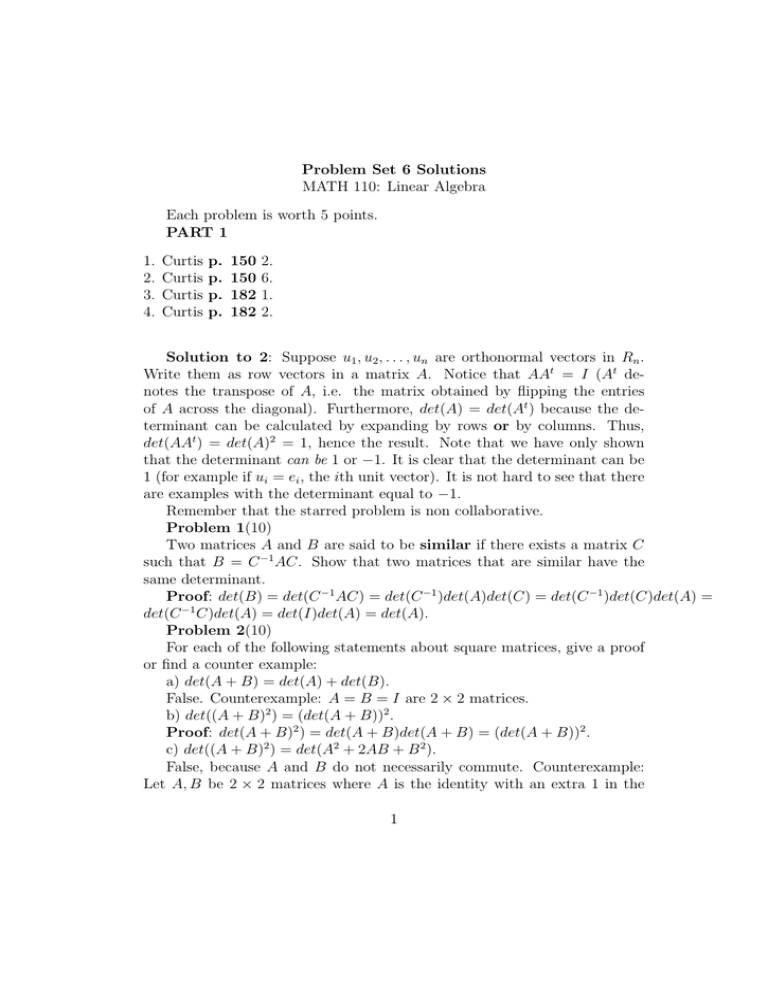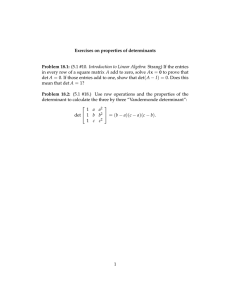Problem Set 6 Solutions MATH 110: Linear Algebra Each problem is
advertisement

Problem Set 6 Solutions MATH 110: Linear Algebra Each problem is worth 5 points. PART 1 1. 2. 3. 4. Curtis Curtis Curtis Curtis p. p. p. p. 150 150 182 182 2. 6. 1. 2. Solution to 2: Suppose u1 , u2 , . . . , un are orthonormal vectors in Rn . Write them as row vectors in a matrix A. Notice that AAt = I (At denotes the transpose of A, i.e. the matrix obtained by flipping the entries of A across the diagonal). Furthermore, det(A) = det(At ) because the determinant can be calculated by expanding by rows or by columns. Thus, det(AAt ) = det(A)2 = 1, hence the result. Note that we have only shown that the determinant can be 1 or −1. It is clear that the determinant can be 1 (for example if ui = ei , the ith unit vector). It is not hard to see that there are examples with the determinant equal to −1. Remember that the starred problem is non collaborative. Problem 1(10) Two matrices A and B are said to be similar if there exists a matrix C such that B = C −1 AC. Show that two matrices that are similar have the same determinant. Proof: det(B) = det(C −1 AC) = det(C −1 )det(A)det(C) = det(C −1 )det(C)det(A) = det(C −1 C)det(A) = det(I)det(A) = det(A). Problem 2(10) For each of the following statements about square matrices, give a proof or find a counter example: a) det(A + B) = det(A) + det(B). False. Counterexample: A = B = I are 2 × 2 matrices. b) det((A + B)2 ) = (det(A + B))2 . Proof: det(A + B)2 ) = det(A + B)det(A + B) = (det(A + B))2 . c) det((A + B)2 ) = det(A2 + 2AB + B 2 ). False, because A and B do not necessarily commute. Counterexample: Let A, B be 2 × 2 matrices where A is the identity with an extra 1 in the 1 upper right hand corner and B has two ones in the first column and two zeros in the second. Then the left hand side of c) is 1 and the right hand side is 0. d) det((A + B)2 ) = det(A2 + B 2 ). False. Counterexample: A = B = I are 2 × 2 matrices. Problem 3 (15) Given n2 functions fij on an interval (a, b) define F (x) = det[fij (x)] for each x in (a, b). Prove that the derivative F 0 (x) is a sum of n determinants F 0 (x) = n X detAi (x). i=1 where Ai (x) is the matrix obtained by differentiating the functions in the ith row of [fij (x)]. P Q Solution: F (x) = σ∈Pn (σ) ni=1 fi,σ(i) . Here σ is a permutation of 1, 2, . . . , n and Pn is the set of all permutations. (σ) is the sign of σ, which is either plus or minus one. Taking the derivative of F (x) we find that F 0 (x) = X σ∈Pn (σ) n X 0 fj,σ(j) j=1 n Y fi,σ(i) . i=1,i6=j This is equal to n X X 0 (σ)fj,σ(j) j=1 σ∈Pn n Y fi,σ(i) i=1,i6=j which is simply nj=1 detAj . Problem 4 (10) Prove Demoivre’s theorem: P (cos θ + i sin θ)n = cos nθ + i sin nθ. Proof: (cos θ + i sin θ)n = (eiθ )n = ei(nθ) = cos nθ + i sin nθ. PART 3 - Optional Problem Let f, g, h be relatively prime nonzero polynomials (not all constant) with f + g = h. Define n0 (f ) to be the number of distinct roots of a polynomials f . Show that max(deg(f ), deg(g), deg(h)) ≤ n0 (f gh) − 1. 2




